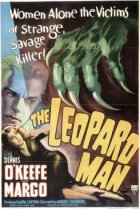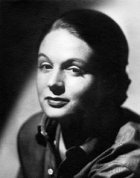
The Leopard Man Page #2
- APPROVED
- Year:
- 1943
- 66 min
- 467 Views
Kiki grins. Jerry reaches for Kiki's hand, and passes the end
of the leash over her fingers.
JERRY:
Come down to earth� and see what a
picture you'd make with this for a
pet.
Keeping a wary eye on the leopard, Kiki lets Jerry help her
down. She stands as far away from the beast as the leash will
permit.
ELOISE:
(warily, from behind the
chair)
And if you've got cold feet honey,
Ill take over for you. That red
dress of yours fits just perfect on
me.
KIKI:
(exasperated, turning to
her)
I bet you try on my coffin some day
-- I hope it "fits just perfect."
JERRY:
(hastily to Kiki)
You look swell in that three�alarm
number --
KIKI:
The red dress?
(thinks a moment)
No. My black one. Then I'll be just
like him.
DISSOLVE TO:
INT. PATIO EL PUEBLO CAPE - NIGHT
CL0SE SHOT - the fountain. The CAMERA is FOCUSED on the
extreme height of the jet of water. We watch the ball on top
of this jet as it rises and falls for a few beats. Over this
shot we hear the music of a Mexican orchestra.
The CAMERA MOVES DOWN and BACK to reveal the upper tier of
the fountain with the water flowing over its edges.
The CAMERA MOVES BACK and we see the wide pool at the base of
the fountain. In this pool we see Clo-Clo reflected, as she
dances.
The CAMERA PANS to take in the actual dancer and we see Clo
Clo whirling and turning in a tight circle. She is
illuminated by several baby spots concealed at the base
of the fountain, and this light makes a nimbus of light
around her. It is a sort of superaura which washes out the
background haze, leaving the dancer clear-cut and sharp in
the midst of this superaura.
As Clo-Clo's dance widens in movement, taking her to the edge
of the light nimbus, we can see her, the tables and the
patrons of El Pueblo.
The El Pueblo cafe is the smartest night club in this small
New Mexican resort town. The main dining room is in the
patio. Here are tables mantled in snowy tablecloths,
glittering candlelight and sparkling glassware. On the porch
is an open space for the performers and the orchestra on one
side On the other side is a bar.
Tonight, El Pueblo is crowded. Waiters, dressed in rather
formal costumes with black trousers and short, white coats,
scurry between the tables. A good portion of -the patrons are
in evening clothes.
Clo�Clo dances. The rhythmic rattle of her castanets beat out
above the orchestra.
Clo-Clo is New Mexican. Like the broncos of her native state,
she is all fine, proud, pure Spanish blood. It has suffered a
change in the high clear air of New Mexico. In her dance,
too, we see the more primeval strain of the Indian twisted
among the finer threads of Spanish rhythm.
She dances. In the pool we see the heavy flutter and turn of
her skirt. Her neck, her bosom, her arms, bend and sway and
turn and pulse with the bloodbeat of the castanets. She is
just entering a graceful turn of the dance, the castanets
beginning a glissade, when suddenly she stops dead, the click
of the castanets cutting off abruptly.
REVERSE SHOT - the doorway leading into the El Pueblo. Framed
in this doorway is Kiki, slim and tall in a black gown with
black gloves, and in her outstretched hand is a black leash
which links her to the leopard. Behind her the doorway is hot
with light so that we see her dramatic outline, a silhouette
against luminosity.
MED. LONG SHOT - the cafe. A buzz of amazement sounds from
the crowd. There is a flutter of astonishment and timidity.
CLOSEUP of Clo�Clo.
MED. CLOSE SHOT of Kiki. Behind her in the doorway Jerry
Manning's face appears. It is obvious that Kiki, despite her
dramatic pose, is surreptitiously nervous.
JERRY:
(sotto voce)
Don't stand here, Kiki. You're on
stage. They're looking at you.
Kiki moves majestically forward.
MED. LONG SHOT � a table near the dance space. Kiki, the
leopard moving before her, threads her way between two
tables, the patrons drawing away from her black escort as she
passes. A waiter, carefully holding the chair between him and
the leopard, makes a place for her at an empty table.
Clo�Clo, feet wide apart, arms and hands still half raised
and holding the castanets, watches. The orchestra plays
feebly on.
Suddenly Clo�Clo smiles. She lifts her hands a little higher,
takes a step forward and lets the castanets loose with a roll
that sounds like machine�gun fire. The leopard startled,:
twists in a half turn of fright, strains suddenly at the
leash and lunges forward. The leash pulls out of Kiki's
frightened hand.
REFLECTION SHOT in the pool. The still water reflects the
quick bound and leap of the leopard in its panic flight for
freedom.
MED. CLOSE SHOT - Kiki. She stands leaning against the table,
trembling in fright. Behind her Clo�Clo can be seen can be
seen on the platform, smiling. Jerry comes into the scene,
puts his arm about Kiki's waist.
JERRY:
Are you all right?
KIKI:
(wildly, and
in disgust)
Now look what you've done.
The familiar tone of anger reassures Jerry.
JERRY:
(briefly)
You are all right.
MED. SHOT - the leopard bounding through the gate.
MED. SHOT at the gate. A waiter with a napkin over his arm
and a water carafe in his hand, stands aghast, pressing his
back to the wall in fear. The water carafe falls with a
crash. The waiter holds up his hand, dazed. His hand is
streaming with blood.
DISSOLVE:
EXT. PASAJE DE LAS SOMBRAS - NIGHT
SHOT of four policemen, their backs toward us, going through
the Alley of the Shadows. Two of them are beating on pots and
pans to make a noise. Two others are flashing their
flashlights from one side to the other.
We TRUCK WITH them down the alley. They bring us to the open
end of the passage, athwart which a fire truck is parked.
Near this fire truck stands the Chief of Police, Robles, a
dignified, well�spoken, Mexican police officer, serious and
conscientious, very much on duty at all times.
ONE OF THE POLICEMEN
No leopard, Chief -- no cat, no
kittens, nothing. We're going to
tackle the houses
Robles nods. He makes a gesture to one of the men on the fire
truck and two long lances of light pierce the darkness of the
alley.
LONG SHOT - Pasaje De Las Sombras. The shafts of light from
the searchlights cross and re-cross, moving, as they explore
the dark jags and corners of the alley. It is one of the
oldest streets in town, so narrow that even at noonday, the
sun has difficulty lightening its dark shadows. The adobe
houses, standing wall to wall, were never built on any
straight geometric line; the street makes a dog-leg,
meandering, as if loathe to reach its own blind end.
MED. LONG SHOT � the mouth of the alley at the other side of
the fire truck. This is a-scene of curiosity and confusion. A
police cordon has been erected, and several uniformed Mexican
policemen are busy shooing away the spectators, foiling the
attempts of small boys to get under the ropes, and generally
trying to reduce chaos to an ordered hunt for the leopard.
At the mouth of the alley, next to the fire truck is parked a
curious conveyance, a half-ton truck with a gaudy sign which
reads:
Translation
Translate and read this script in other languages:
Select another language:
- - Select -
- 简体中文 (Chinese - Simplified)
- 繁體中文 (Chinese - Traditional)
- Español (Spanish)
- Esperanto (Esperanto)
- 日本語 (Japanese)
- Português (Portuguese)
- Deutsch (German)
- العربية (Arabic)
- Français (French)
- Русский (Russian)
- ಕನ್ನಡ (Kannada)
- 한국어 (Korean)
- עברית (Hebrew)
- Gaeilge (Irish)
- Українська (Ukrainian)
- اردو (Urdu)
- Magyar (Hungarian)
- मानक हिन्दी (Hindi)
- Indonesia (Indonesian)
- Italiano (Italian)
- தமிழ் (Tamil)
- Türkçe (Turkish)
- తెలుగు (Telugu)
- ภาษาไทย (Thai)
- Tiếng Việt (Vietnamese)
- Čeština (Czech)
- Polski (Polish)
- Bahasa Indonesia (Indonesian)
- Românește (Romanian)
- Nederlands (Dutch)
- Ελληνικά (Greek)
- Latinum (Latin)
- Svenska (Swedish)
- Dansk (Danish)
- Suomi (Finnish)
- فارسی (Persian)
- ייִדיש (Yiddish)
- հայերեն (Armenian)
- Norsk (Norwegian)
- English (English)
Citation
Use the citation below to add this screenplay to your bibliography:
Style:MLAChicagoAPA
"The Leopard Man" Scripts.com. STANDS4 LLC, 2025. Web. 3 Mar. 2025. <https://www.scripts.com/script/the_leopard_man_896>.







Discuss this script with the community:
Report Comment
We're doing our best to make sure our content is useful, accurate and safe.
If by any chance you spot an inappropriate comment while navigating through our website please use this form to let us know, and we'll take care of it shortly.
Attachment
You need to be logged in to favorite.
Log In